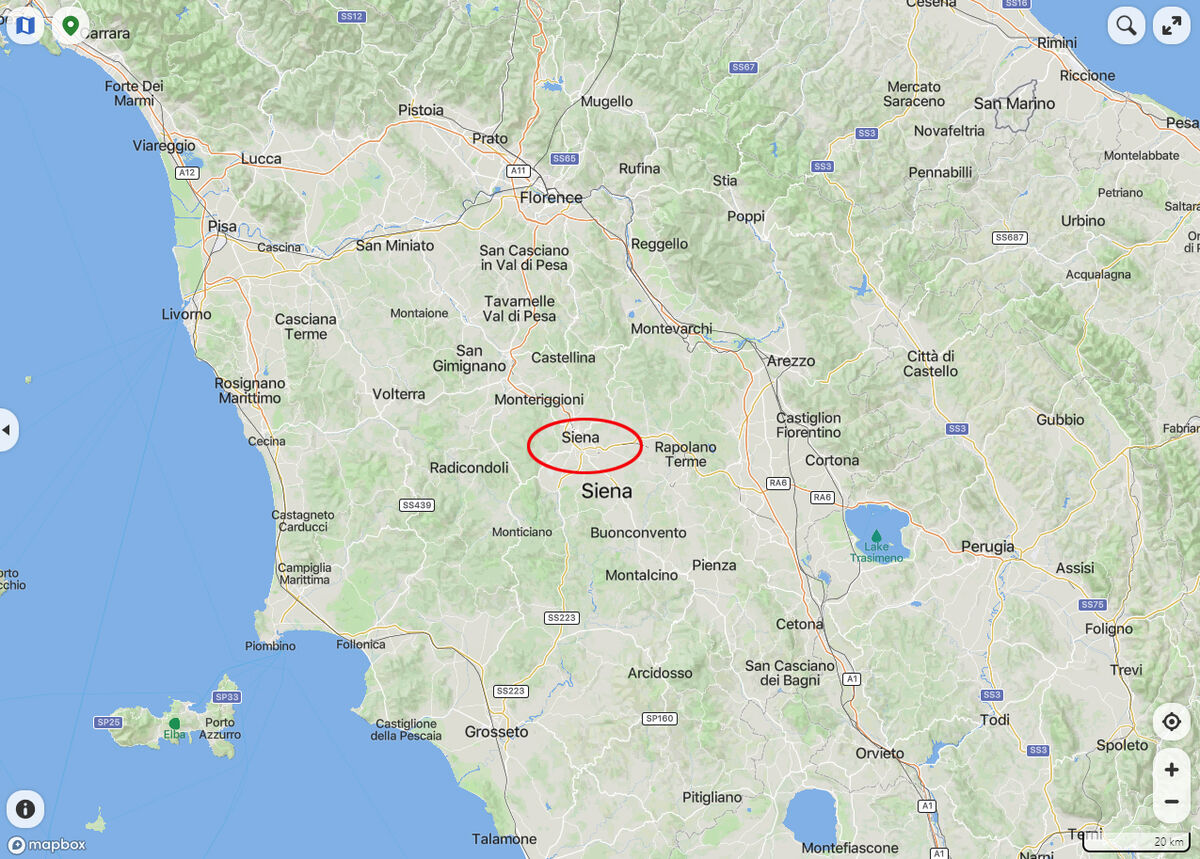Italy: Siena - Views From Our Balcony
Jan 19, 2024 13:53:30 #
We arrived in the bus drop off area on the outskirts of the old town and were transferred to waiting cabs for our short ride to the hotel - The magnificent Grand Hotel Continental. We were fortunate to get a top floor room with a balcony overlooking the city. These views will be the subject of my next few posts.
Siena (/siˈɛnə/ see-EN-ə, Italian: [ˈsjɛːna, ˈsjeːna] ⓘ; Latin: Sena Iulia) is a city in Tuscany, Italy. It is the capital of the province of Siena. Siena is the 12th largest city in the region by number of inhabitants, with a population of 53,062 as of 2022.
The city is historically linked to commercial and banking activities, having been a major banking center until the 13th and 14th centuries. Siena is also home to the oldest bank in the world, the Monte dei Paschi bank, which has been operating continuously since 1472 (552 years ago). Several significant Renaissance painters were born and worked in Siena, among them Duccio, Ambrogio Lorenzetti, Simone Martini and Sassetta, and influenced the course of Italian and European art. The University of Siena, originally called Studium Senese, was founded in 1240, making it one of the oldest universities in continuous operation in the world.
Siena was one of the most important cities in medieval Europe, and its historic centre is a UNESCO World Heritage Site, which contains several buildings from the 13th and 14th centuries. The city is famous for its cuisine, art, museums, medieval cityscape and the Palio, a horse race held twice a year in Piazza del Campo.
History
Antiquity
According to a legend, Siena was founded by Senius and Aschius, two sons of Remus. When they fled Rome, they took the statue of the She-wolf to Siena, which became a symbol of the town.
Siena, like other Tuscan hill towns, was first settled in the time of the Etruscans (c. 900–400 BC) when it was inhabited by a tribe called the Saina. A Roman town called Saena Julia was founded at the site in the time of the Emperor Augustus.
According to local legend, Siena was founded by Senius and Aschius, two sons of Remus and thus nephews of Romulus, after whom Rome was named. Supposedly after their father's murder by Romulus, they fled Rome, taking with them the statue of the she-wolf suckling the infants (Capitoline Wolf), thus appropriating that symbol for the town. Additionally they rode white and black horses, giving rise to the Balzana, or coat of arms of Siena with a white band atop a dark band. Some claim the name Siena derives from Senius. Other etymologies derive the name from the Etruscan family name Saina, the Roman family name Saenii, or the Latin word senex "old" or its derived form seneo "to be old".
The first known document of the Sienese community dates back to 70 AD: The Roman Senator Manlio Patruito reported to Rome that he had been ridiculed with a fake funeral during his official visit to Saena Iulia, a small military colony in Tuscia. The Roman Senate decided to punish the main culprits and to severely call the Sienese to greater respect for Roman authority.
At the end of the third century the Christianization of the territory also took place by Sant'Ansano, known precisely as the "Baptizer of the Sienese", who was in fact punished by the Roman authorities governing Siena with the test of fire and boiling oil, imprisonment and finally beheading. During the Middle Ages he will therefore be named patron saint of Siena and the day of his liturgical anniversary will mark the beginning of the "Contrada Year".
Middle Ages
Feudal power waned, however, and by the death of Countess Matilda in 1115 the border territory of the March of Tuscany which had been under the control of her family, the Canossa, broke up into several autonomous regions. This ultimately resulted in the creation of the Republic of Siena.
The Republic existed for over four hundred years, from the 12th century until 1555. During the golden age of Siena before the Black Death in 1348, the city was home to 50,000 people. A major economic centre and among the most important cities in Europe, as well as the main political, economic, and artistic rival of its neighboring city of Florence.
From 1547 to 1552, the Spanish-installed governor of Siena was Diego Hurtado de Mendoza, until he was ousted by a Sienese revolt, which reestablished the Sienese Republic. In the Italian War of 1551–59, the republic was defeated by the rival Florence in alliance with the Spanish crown. After 18 months of resistance, Siena surrendered to Spain on 17 April 1555, marking the end of the republic.
Medicean period
After the fall of the Republic, a few Sienese led by the Florentine exile Piero Strozzi, not wanting to accept the fall of the Republic, took refuge in Montalcino, creating the Republic of Siena sheltered in Montalcino. It lived until 31 May 1559 when it was betrayed by the French allies, whom Siena had always supported, concluding with the Peace of Cateau Cambrésis with Charles V, which effectively ceded the Republic to the Medici.
The House of Medici, apart from the brief parenthesis of Ferdinando I, who tried to create an organized state, were not able to give a stable structure to the Grand Duchy of Tuscany, keeping almost unchanged the division between the so-called Old State, i.e. Florence, and the New State, i.e. Siena and the southern part up to Pitigliano, with different laws and taxes. With the death of Gian Gastone de' Medici, (1737), who had no children, the Medici dynasty ended and the Grand Duchy passed into the hands of the Habsburg-Lorraine dinasty who kept it until 1799.
Late modern period
After the Napoleonic period and the Risorgimento uprisings, Siena was the first city in Tuscany, in 1859, to vote in favour of annexation to the Kingdom of Italy.
Geography
Siena is located in the central part of Tuscany, in the middle of a vast hilly landscape between the Arbia river valley (south), the Merse valley (south-west), the Elsa valley (north), the Chianti hills (north-east), the Montagnola Senese (west) and the Crete Senesi (south-east). The city lies at 322 m (1,056 ft) above sea level.
Economy
The main activities are tourism, services, agriculture, handicrafts and light industry.
In 2009 agricultural activity comprised 919 companies with a total area of 10.755 square kilometres (4.153 sq mi) for a usable agricultural area of 6.954 square kilometres (2.685 sq mi) or about 1⁄30 of the total municipal area (data ISTAT for the 2000 Agriculture Census V).
There is little manufacturing in the city. One exception is the seasonal confectionery industry, which produces local specialities including panforte, ricciarelli and cavallucci at Christmas, and pane co' santi for I Santi on 1 November and I Morti on the following day.
The area has also seen a growth in biotechnology. The Centenary Institute Sieroterapico Achille Sclavo used to be Swiss-owned, operating under the company name, Novartis Vaccines. Novartis developed and produced vaccines and employed about a thousand people. In 2015, the research plant in Siena became part of Glaxo Smith Kline, as part of a deal between Novartis and this firm.
Culture
Siena retains a ward-centric culture from medieval times. Each ward (contrada) is represented by an animal or mascot and has its own boundary and distinct identity. Ward rivalries are most rampant during the annual horse race (Palio) in the Piazza del Campo. There are 17 wards (contrada): Aquila, Bruco, Chiocciola, Civetta, Drago, Giraffa, Istrice, Leocorno, Lupa, Nicchio, Oca, Onda, Pantera, Selva, Tartuca, Torre, Valdimontone.
More about Siena in my upcoming posts.
I hope you enjoy these!
Mark
Siena (/siˈɛnə/ see-EN-ə, Italian: [ˈsjɛːna, ˈsjeːna] ⓘ; Latin: Sena Iulia) is a city in Tuscany, Italy. It is the capital of the province of Siena. Siena is the 12th largest city in the region by number of inhabitants, with a population of 53,062 as of 2022.
The city is historically linked to commercial and banking activities, having been a major banking center until the 13th and 14th centuries. Siena is also home to the oldest bank in the world, the Monte dei Paschi bank, which has been operating continuously since 1472 (552 years ago). Several significant Renaissance painters were born and worked in Siena, among them Duccio, Ambrogio Lorenzetti, Simone Martini and Sassetta, and influenced the course of Italian and European art. The University of Siena, originally called Studium Senese, was founded in 1240, making it one of the oldest universities in continuous operation in the world.
Siena was one of the most important cities in medieval Europe, and its historic centre is a UNESCO World Heritage Site, which contains several buildings from the 13th and 14th centuries. The city is famous for its cuisine, art, museums, medieval cityscape and the Palio, a horse race held twice a year in Piazza del Campo.
History
Antiquity
According to a legend, Siena was founded by Senius and Aschius, two sons of Remus. When they fled Rome, they took the statue of the She-wolf to Siena, which became a symbol of the town.
Siena, like other Tuscan hill towns, was first settled in the time of the Etruscans (c. 900–400 BC) when it was inhabited by a tribe called the Saina. A Roman town called Saena Julia was founded at the site in the time of the Emperor Augustus.
According to local legend, Siena was founded by Senius and Aschius, two sons of Remus and thus nephews of Romulus, after whom Rome was named. Supposedly after their father's murder by Romulus, they fled Rome, taking with them the statue of the she-wolf suckling the infants (Capitoline Wolf), thus appropriating that symbol for the town. Additionally they rode white and black horses, giving rise to the Balzana, or coat of arms of Siena with a white band atop a dark band. Some claim the name Siena derives from Senius. Other etymologies derive the name from the Etruscan family name Saina, the Roman family name Saenii, or the Latin word senex "old" or its derived form seneo "to be old".
The first known document of the Sienese community dates back to 70 AD: The Roman Senator Manlio Patruito reported to Rome that he had been ridiculed with a fake funeral during his official visit to Saena Iulia, a small military colony in Tuscia. The Roman Senate decided to punish the main culprits and to severely call the Sienese to greater respect for Roman authority.
At the end of the third century the Christianization of the territory also took place by Sant'Ansano, known precisely as the "Baptizer of the Sienese", who was in fact punished by the Roman authorities governing Siena with the test of fire and boiling oil, imprisonment and finally beheading. During the Middle Ages he will therefore be named patron saint of Siena and the day of his liturgical anniversary will mark the beginning of the "Contrada Year".
Middle Ages
Feudal power waned, however, and by the death of Countess Matilda in 1115 the border territory of the March of Tuscany which had been under the control of her family, the Canossa, broke up into several autonomous regions. This ultimately resulted in the creation of the Republic of Siena.
The Republic existed for over four hundred years, from the 12th century until 1555. During the golden age of Siena before the Black Death in 1348, the city was home to 50,000 people. A major economic centre and among the most important cities in Europe, as well as the main political, economic, and artistic rival of its neighboring city of Florence.
From 1547 to 1552, the Spanish-installed governor of Siena was Diego Hurtado de Mendoza, until he was ousted by a Sienese revolt, which reestablished the Sienese Republic. In the Italian War of 1551–59, the republic was defeated by the rival Florence in alliance with the Spanish crown. After 18 months of resistance, Siena surrendered to Spain on 17 April 1555, marking the end of the republic.
Medicean period
After the fall of the Republic, a few Sienese led by the Florentine exile Piero Strozzi, not wanting to accept the fall of the Republic, took refuge in Montalcino, creating the Republic of Siena sheltered in Montalcino. It lived until 31 May 1559 when it was betrayed by the French allies, whom Siena had always supported, concluding with the Peace of Cateau Cambrésis with Charles V, which effectively ceded the Republic to the Medici.
The House of Medici, apart from the brief parenthesis of Ferdinando I, who tried to create an organized state, were not able to give a stable structure to the Grand Duchy of Tuscany, keeping almost unchanged the division between the so-called Old State, i.e. Florence, and the New State, i.e. Siena and the southern part up to Pitigliano, with different laws and taxes. With the death of Gian Gastone de' Medici, (1737), who had no children, the Medici dynasty ended and the Grand Duchy passed into the hands of the Habsburg-Lorraine dinasty who kept it until 1799.
Late modern period
After the Napoleonic period and the Risorgimento uprisings, Siena was the first city in Tuscany, in 1859, to vote in favour of annexation to the Kingdom of Italy.
Geography
Siena is located in the central part of Tuscany, in the middle of a vast hilly landscape between the Arbia river valley (south), the Merse valley (south-west), the Elsa valley (north), the Chianti hills (north-east), the Montagnola Senese (west) and the Crete Senesi (south-east). The city lies at 322 m (1,056 ft) above sea level.
Economy
The main activities are tourism, services, agriculture, handicrafts and light industry.
In 2009 agricultural activity comprised 919 companies with a total area of 10.755 square kilometres (4.153 sq mi) for a usable agricultural area of 6.954 square kilometres (2.685 sq mi) or about 1⁄30 of the total municipal area (data ISTAT for the 2000 Agriculture Census V).
There is little manufacturing in the city. One exception is the seasonal confectionery industry, which produces local specialities including panforte, ricciarelli and cavallucci at Christmas, and pane co' santi for I Santi on 1 November and I Morti on the following day.
The area has also seen a growth in biotechnology. The Centenary Institute Sieroterapico Achille Sclavo used to be Swiss-owned, operating under the company name, Novartis Vaccines. Novartis developed and produced vaccines and employed about a thousand people. In 2015, the research plant in Siena became part of Glaxo Smith Kline, as part of a deal between Novartis and this firm.
Culture
Siena retains a ward-centric culture from medieval times. Each ward (contrada) is represented by an animal or mascot and has its own boundary and distinct identity. Ward rivalries are most rampant during the annual horse race (Palio) in the Piazza del Campo. There are 17 wards (contrada): Aquila, Bruco, Chiocciola, Civetta, Drago, Giraffa, Istrice, Leocorno, Lupa, Nicchio, Oca, Onda, Pantera, Selva, Tartuca, Torre, Valdimontone.
More about Siena in my upcoming posts.
I hope you enjoy these!
Mark

(Download)

(Download)
The Torre del Mangia above the rooftops
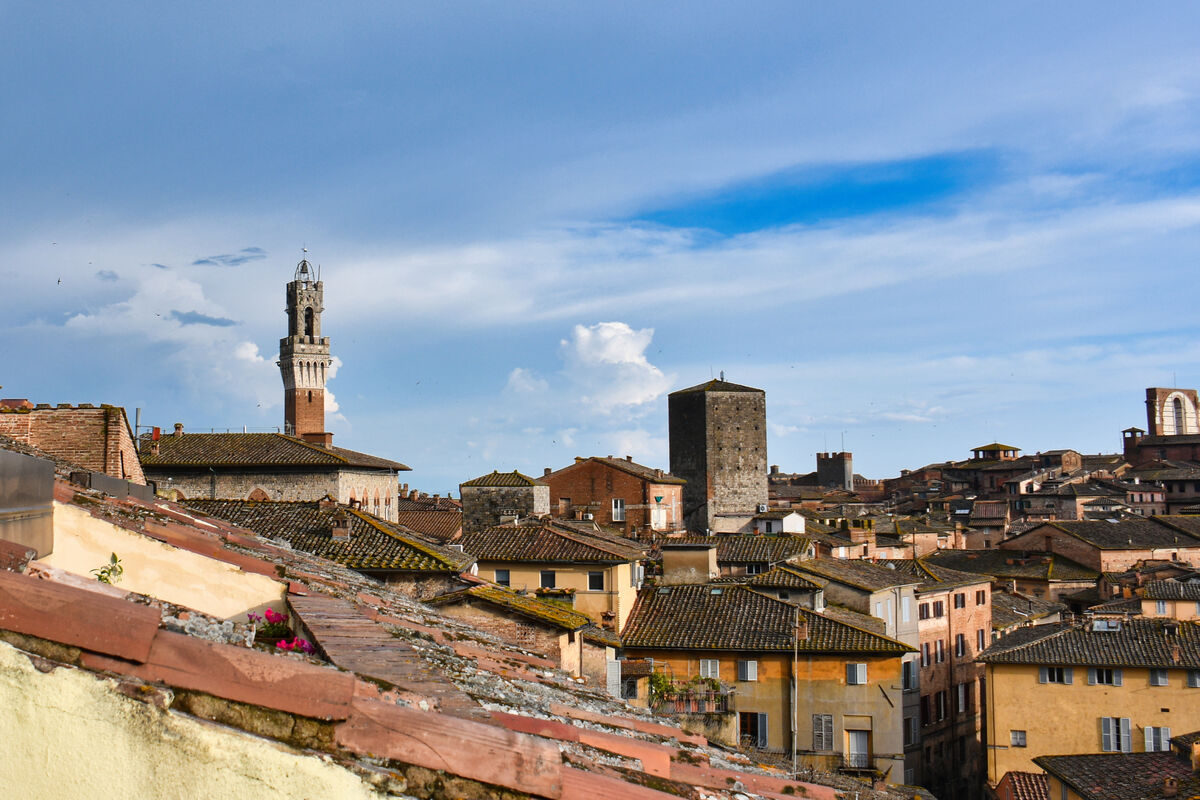
(Download)

(Download)
Basilica of San Domenico originally built during the 13th century, enlarged in the 14th century and destroyed and rebuilt several times in the following years. It has several relics of Saint Catherine of Siena It is also know as Basilica Cateriniana.
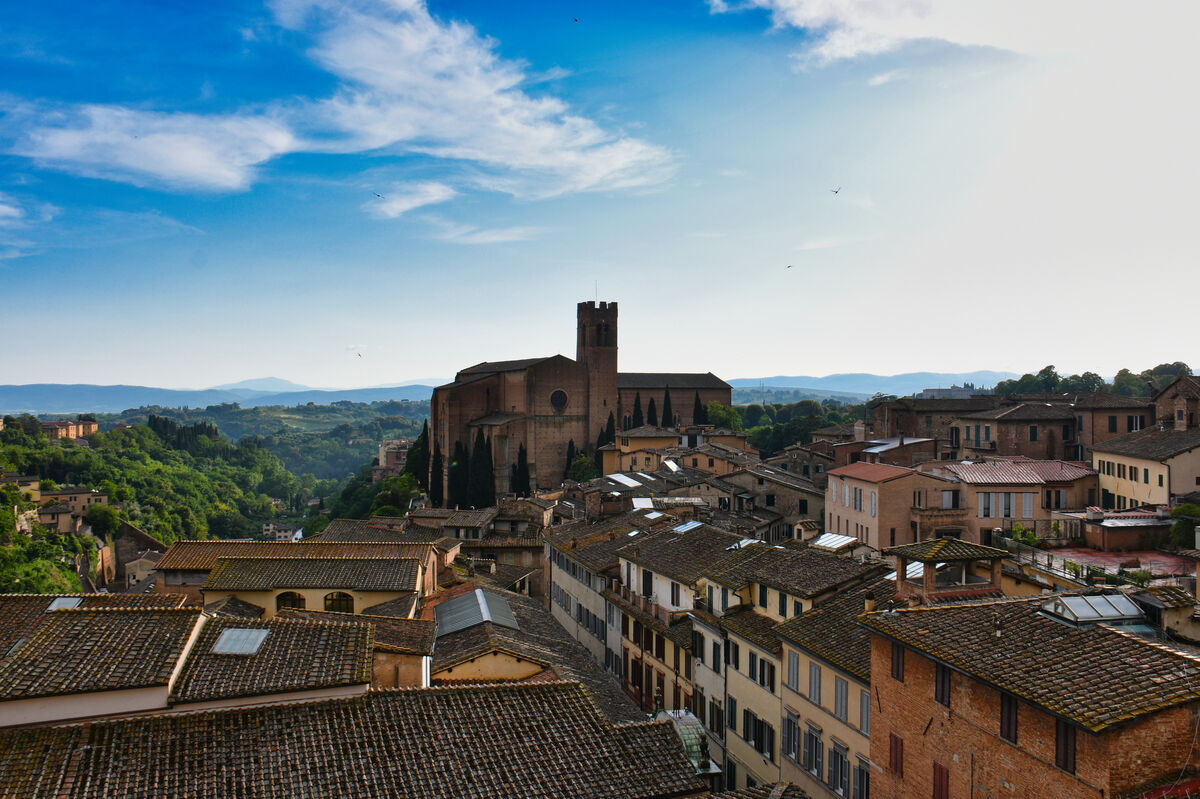
(Download)
Siena Cathedral (Duomo di Siena) is dedicated to the Assumption of Mary. It was designed and completed between 1215 and 1263. The dome was completed in 1264 with a Bernini lantern on top. The oldest of the 6 bells was cast was cast in 1149
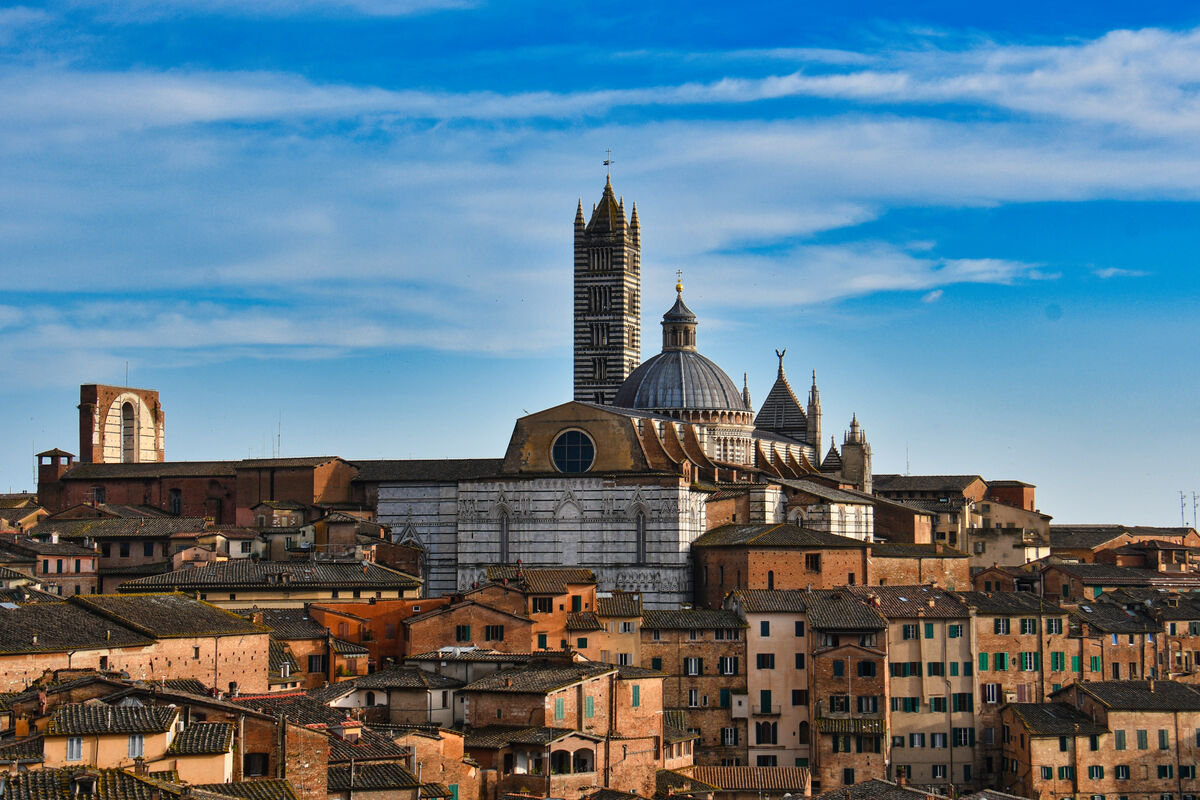
(Download)
The Torre del Mangia Built in 1338-1348 is located in the Piazza del Campo, Siena's main square, next to the Palazzo Pubblico (Town Hall).
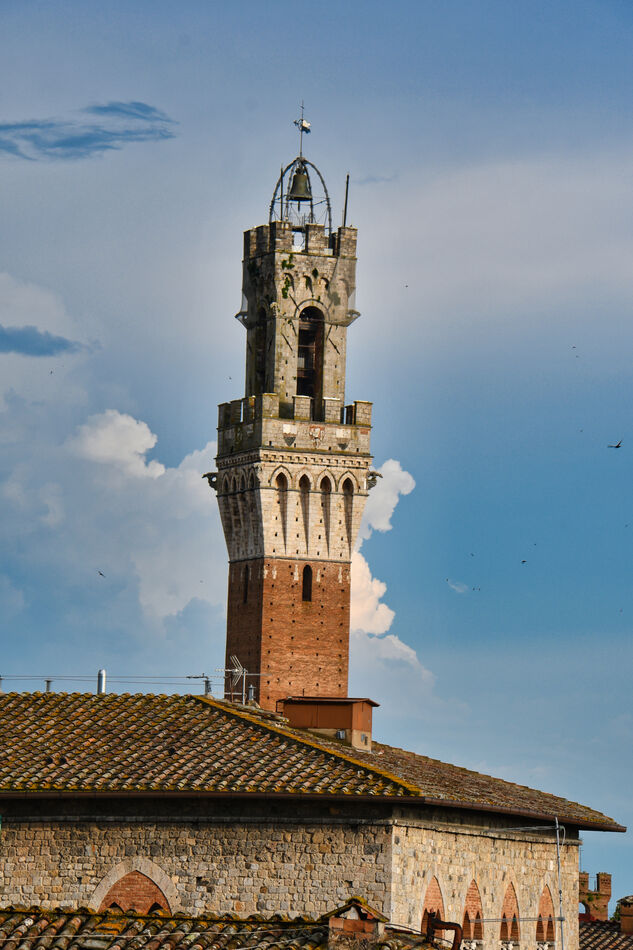
(Download)
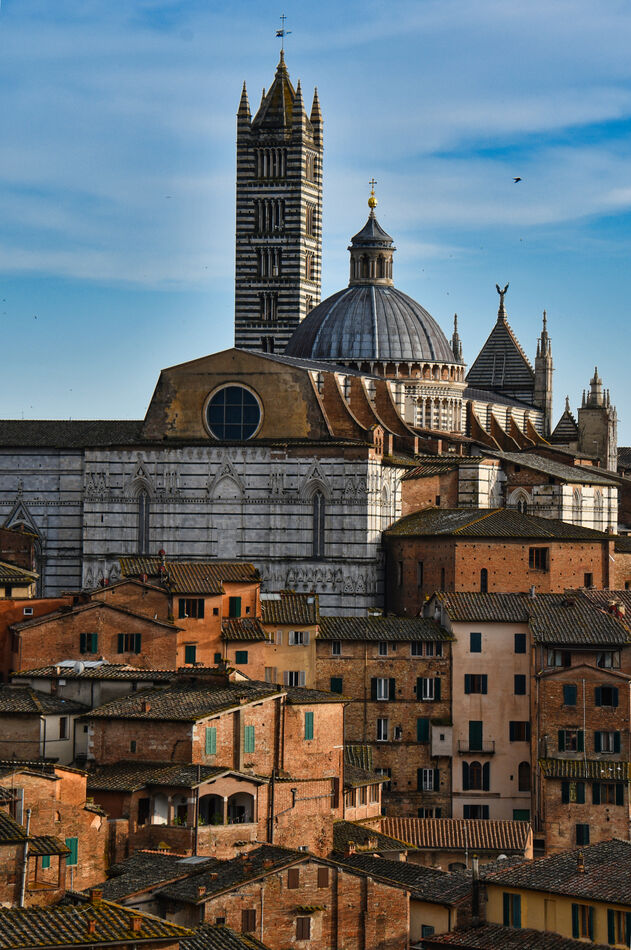
(Download)
The unfinished nave extension of the Cathedral begun in 1339 and halted by "The Black Death" in 1348. It was never completed due to construction errors. The outer walls pictured are south of the Duomo.
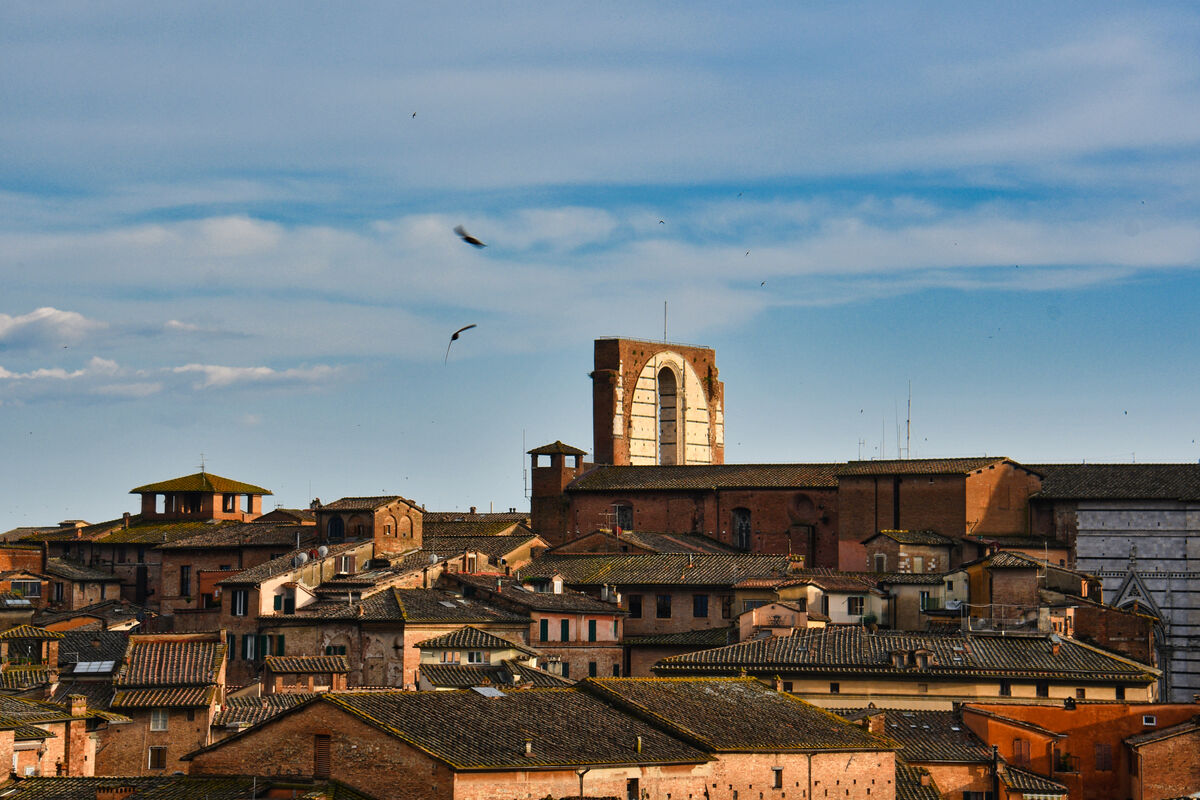
(Download)
The exterior and interior of the Cathedral are constructed of white and greenish-black marble in alternating stripes. Black and white are the symbolic colors of Siena, linked to black and white horses of the city's founders, Senius and Aschius
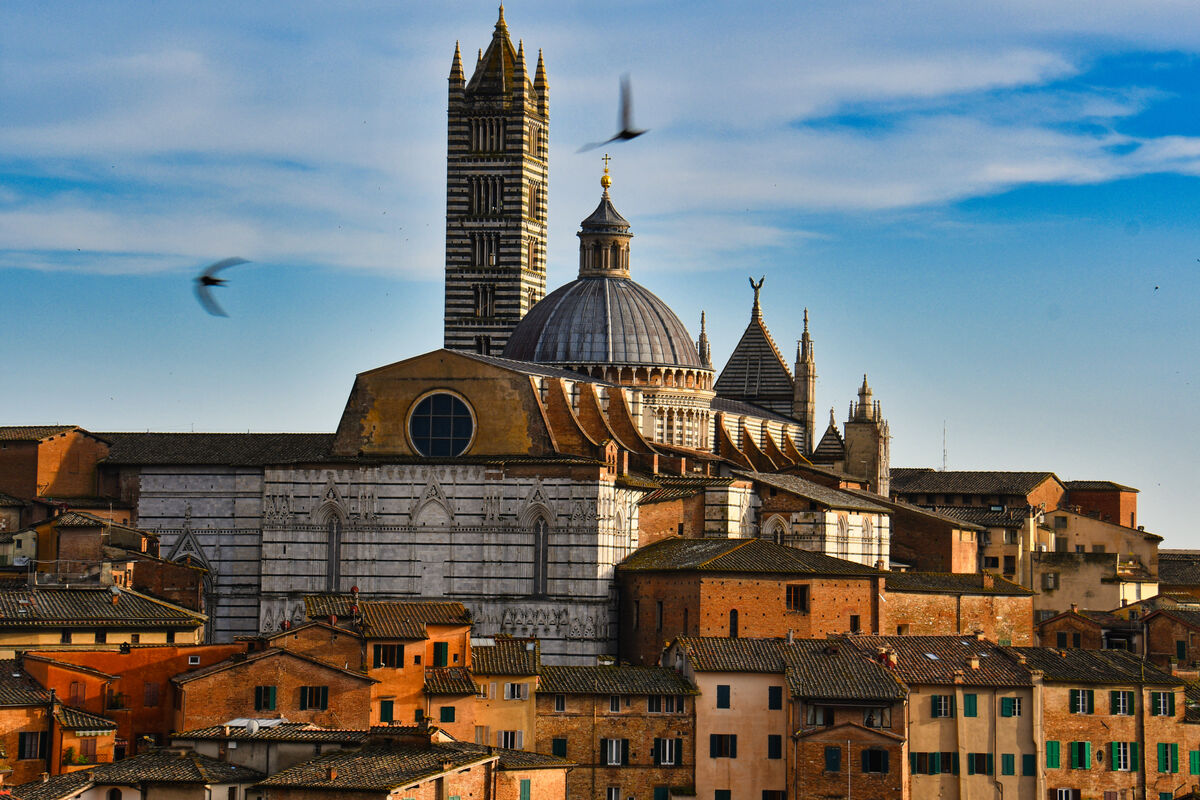
(Download)
Jan 19, 2024 13:54:19 #
Jan 19, 2024 14:12:55 #
Jan 19, 2024 14:14:26 #
UTMike wrote:
Beautiful views, Mark, esp. #1!
Thanks very much Mike. I was happy to get her out there!
Jan 19, 2024 15:16:43 #
srfmhg wrote:
We arrived in the bus drop off area on the outskir... (show quote)
Beautiful photos Mark; they brought back good memories from our visit to Siena in May 2023. The Siena Cathedral was one of our favorites in our month-long drive around Italy.
Jan 19, 2024 18:51:20 #
Jan 19, 2024 19:07:29 #
Jan 19, 2024 20:01:13 #
DJphoto wrote:
Beautiful photos Mark; they brought back good memories from our visit to Siena in May 2023. The Siena Cathedral was one of our favorites in our month-long drive around Italy.
Thanks so much Dennis. Glad they brought back pleasant memories. I'm anxious to see your photos from your Italy trip.
Jan 19, 2024 20:01:55 #
dreff wrote:
Thanks for the tour!
You're most welcome Dreff. Thank you for coming along!
Jan 19, 2024 20:03:31 #
kpmac wrote:
Looks sorta cluttered but it sure is scenic, Mark. Nice set.
Thanks very much ken. That's the case with most old Italian cities. I do prefer the countryside, but the history and art of the cities also fascinate me.
Jan 19, 2024 20:07:32 #
Siena was one of our favorite places to visit. Thanks for sharing your remarkable photos, Mark.
Jan 19, 2024 20:08:42 #
vicksart wrote:
Siena was one of our favorite places to visit. Thanks for sharing your remarkable photos, Mark.
You're most welcome Vicki. I'm glad these brought back pleasant memories. Many more to come.
Jan 20, 2024 00:38:50 #
srfmhg wrote:
We arrived in the bus drop off area on the outskir... (show quote)
Love those panoramic ancient city views, Mark! Pictures are sharp and well detailed. Nice work!
Jan 20, 2024 06:08:36 #
srfmhg wrote:
We arrived in the bus drop off area on the outskir... (show quote)
Great opening image!!!
The rest are also great!!
Jan 20, 2024 07:36:24 #
If you want to reply, then register here. Registration is free and your account is created instantly, so you can post right away.

